The Changing World of The Executive
by Peter Drucker — his other books

#Note the number of books about Drucker ↓
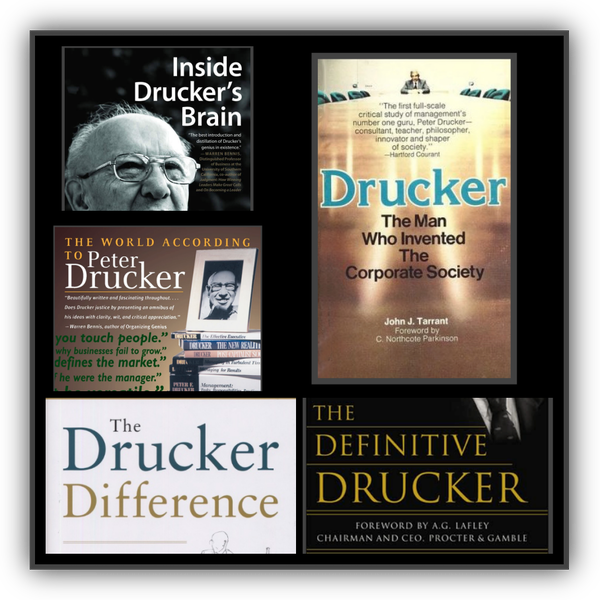
My life as a knowledge worker
Drucker: a political or social ecologist ↑ ↓
“I am not a ‘theoretician’;
through my consulting practice
I am in daily touch with
the concrete opportunities and problems
of a fairly large number of institutions,
foremost among them businesses
but also hospitals, government agencies
and public-service institutions
such as museums and universities.
And I am working with such institutions
on several continents:
North America, including Canada and Mexico;
Latin America; Europe;
Japan and South East Asia.
Still, a consultant is at one remove
from the day-today practice —
that is both his strength
and his weakness.
And so my viewpoint
tends more to be that of an outsider.”
broad worldview ↑
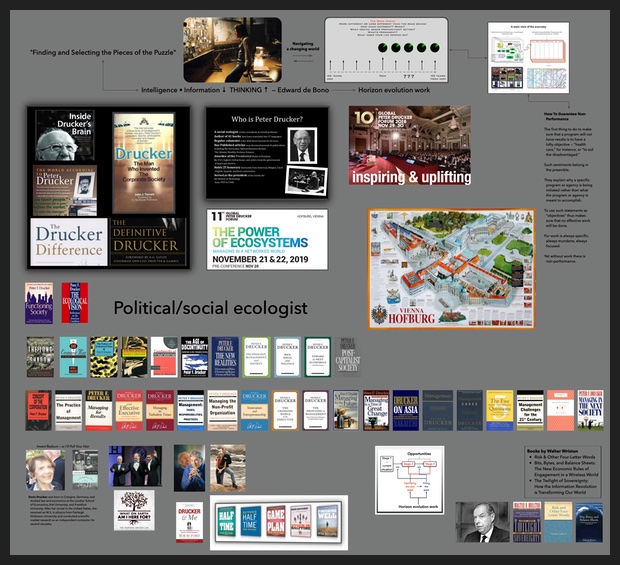
#pdw larger ↑ ::: Books by Peter Drucker ::: Rick Warren + Drucker
Books by Bob Buford and Walter Wriston
Global Peter Drucker Forum ::: Charles Handy — Starting small fires
Post-capitalist executive ↑

Learning to Learn (ecological awareness ::: operacy)
The MEMO they don’t want you to see

See rlaexp.com initial bread-crumb trail — toward the
end of this page — for a site “overview”
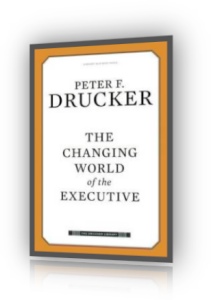
Amazon link: The Changing World of the Executive (Drucker Library)
See about management

Introduction: A Society of Organizations
See Post-Capitalist Society ::: The Characteristics Of Organizations
for more breadth and depth
SOCIETY in this century has become a society of organizations.
Social tasks which only a century ago were done by the family, in the home, in the shop, or on the farm—from providing goods and services to education and care of the sick and the elderly—are increasingly performed in and through large organizations.
These organizations—whether business enterprises, hospitals, schools, or universities—are designed for continuity and run by professional managers.
Executives have thus become the leadership groups in our society.
The leadership groups of old—whether nobles, priests, landed aristocracy, or business tycoons—have disappeared or become peripheral.
The first job of the executive is to make his organization perform.
Results are always on the outside.
There are only costs on the inside.
Even the most efficient manufacturing plant is still a cost center until a distant customer has paid for its products.
The executive thus lives in a constant struggle to keep performance from being overtaken by the concerns of the inside, that is by bureaucracy.
Business at least stands under the control of the market, which forces even the most powerful corporation to subordinate its inside concerns to outside results and to performance.
But in the public service institution, where the market test is absent—and in many cases cannot even be simulated—bureaucracy constantly threatens to swallow up performance.
For the business enterprise in a market system we are gradually developing a discipline of entrepreneurship, that is, of performance.
But even the President of the United States fights a losing battle to preserve his capacity to give political leadership and to make political decisions in the face of the need to manage an unmanageably large, unmanageably complex, and self-centered bureaucratic machine.
The art and discipline of entrepreneurship to make organizations perform and to produce results will therefore be a continuing concern.
This concern will involve the public service institution as well as the business enterprise.
The executive as a person—as a key individual in society and as a member of his organization—becomes a matter of increasing importance.
Middle managers and other professionals working as individual contributors—as engineers, as chemists, as accountants, as computer programers, as medical technologists, and so on—have constituted the fastest-growing group in American society, and indeed in the society of all developed countries.
Careers in organizations—that is, careers as managers and other professionals—are the principal career opportunities for educated people.
Nine out of ten youngsters who receive a college degree can expect to spend all their working lives as managerial or other professional employees of institutions.
Social theorists and political scientists still, by and large, divide the world into “bosses” and “working stiffs.”
But this was the reality of the nineteenth century.
The reality of today consists of people who are “bosses” but who also have bosses of their own; who are not “capitalists” but who collectively—through their pension funds and their savings—own the economy; people who consider themselves “professionals” but who are also “employees” as “professionals” traditionally were not supposed to be.
Who are they?
What do they represent?
Where do they stand?
What are their problems, their opportunities, their concerns?
How can they best use their organizations to achieve their own ends in life and work?
And what, in turn, do they owe the organizations that enable them to live comfortable, well-paid, middle-class lives by furnishing the capital they themselves lack and by taking the risks that they could not afford or dare to take themselves?
There are, of course, many other concerns of management and manager: the impact of new technology, labor relations, government regulation, and growing worldwide economic integration; taxation and compensation; rapidly changing internal organization; and the development of managers.
There is the curious ambivalence in our society that shows an apparently hostile face to business and to large organizations but that also favors business schools to the extent that they have become the fastest-growing institutions of higher education.
Indeed, the Master of Business Administration degree has become increasingly important for advancement in public service organizations as well as in businesses.
There is the changing age structure of society, which for the young adult is creating a climate of extreme competition.
And increasingly, too, there is the desire for a second career for the middle-aged manager and professional—a problem for the individual and a challenge to the organization that employs him.
See Post-Capitalist Society ::: The Characteristics Of Organizations
for more breadth and depth
More on The Society of Organizations
Despite all the outpouring of management writing these last twenty-five years, the world of management is still little-explored.
It is a world of issues, but also a world of people.
And it is undergoing rapid change right now.
These essays explore a wide variety of topics.
They deal with changes in the work force, its jobs, its expectations, with the power relationships of a “society of employees,” and with changes in technology and in the world economy.
They discuss the problems and challenges facing major institutions, including business enterprises, schools, hospitals, and government agencies.
They look anew at the tasks and work of executives, at their performance and its measurement and at executive compensation.
However diverse the topics, all the pieces reflect upon the same reality: In all developed countries the workaday world has become a “society of organizations” and thus dependent on executives, that is on people—whether called managers or administrators—who are paid to direct organizations and to make them perform.
These chapters have one common theme: the changing world of the executive—changing rapidly within the organization; changing rapidly in respect to the visions, aspirations, and even characteristics of employees, customers, and constituents; changing outside the organization as well—economically, technologically, socially, politically.
Of the more than three dozen chapters in this volume thirty-nine appeared first on the editorial page of The Wall Street Journal, one—number 23, “The Professor as Featherbedder”—first appeared in the Chronicle of Higher Education, and the final chapter, “The Matter of Business Ethics,” was originally written for The Public Interest and published there.
This book has two aims.
One is to give insight into—and an understanding of—this world of the executive.
The second is to provide a useful “executive agenda.”
Modern organization, as we now know it, is barely one hundred years old.
It did not become conceptually visible and an object of study until World War II—less than half a century ago.
This new continent has been named and its outlines can be delineated.
But otherwise we are still in a fairly early stage of its exploration.
My second aim for this book, as an executive agenda, is to stimulate both thought and action and to be read with this overriding question in mind:
“How can I, and we in my organization, use this idea or these insights to perform more effectively—to do a better job and, above all, to welcome and accommodate the new and the different?”

- The Changing World of The Executive (by Peter Drucker)
- A Society of Organizations — see above
- EXECUTIVE AGENDA
- BUSINESS PERFORMANCE
- THE NON-PROFIT SECTOR
- Managing the Non-Profit Institution
- Managing the Knowledge Worker
- Meaningful Government Reorganization
- The Decline of Unionization
- The Future of Health Care
- The Professor as Featherbedder
- The Schools in 1990
- PEOPLE AT WORK
- Unmaking the Nineteenth Century
- Retirement Policy
- Report on the Class of 68
- Meaningful Unemployment Figures
- Baby Boom Problems
- Planning for Redundant Workers
- Job as a Property Right
- THE CHANGING GLOBE
- The rise of Production Sharing
- Japan's Economic Policy Turn
- The Battle Over Co-Determination
- A troubled Japanese Juggernaut
- India & appropriate Technology
- Toward a New Form of Money?
- How Westernized Are the Japanese?
- Needed: A Full-Investment Budget
- A return to Hard Choices
- THE MATTER OF BUSINESS ETHICS

Inflation-Proofing the Company
EVERY WEEK, it seems, another book comes out announcing the one sure way to protect the individual and his money against inflation.
But no one seems to pay much attention to protecting business.
And yet little individual wealth is likely to survive unless the economy’s wealth-generating assets, its businesses, retain their capacity to produce.
And that this capacity is endangered by prolonged inflation—let alone by chronic inflation at high rates such as the whole world is now experiencing—everyone accepts, including even the “progressive” economists for whom inflation is very much the lesser evil.
It is impossible for a business—and indeed for an individual as well—to acquire total immunity against the ravages of inflation.
But it is possible to “inflation-proof” a business so as to give it both a fair degree of resistance against the pandemic disease and the power to recover.
And it can be done quite cheaply and with moderate efforts.
The first thing to do—indeed the absolute prerequisite—is to get the facts.
A business that does not adjust its figures to inflation—and only a few big companies are so far doing so in the U.S. cannot fight inflation but becomes its victim.
It is bound to do things that greatly increase inflation’s damage for the simple reason that it bases its decisions on misinformation and self-delusion.
Without inflation-adjusted accounting, businesses must believe that their sales go up when in effect both sales and market standing go down.
They must believe that they are making record profits when, in effect, profitability goes down or disappears entirely.
They must believe that they are financially strong when, in effect, they are on the brink of insolvency and have no power of resistance against “credit crunch” and “liquidity crisis”—both endemic in an inflationary period.
Sales and market standing, receivables and inventory; depreciation, capital, and debt-service requirements; and profits need to be restated continuously in inflation-adjusted figures to enable the business to inflation-proof itself.
The next step is systematic money management.
One of the inevitable distortions of an inflationary period is overemphasis on finance.
Manipulating money comes to be seen as more important than making and marketing goods or services when, with interest rates at 17 percent, an inept or inexperienced treasurer can lose the firm more money in a week than marketing can make in three months.
But to inflation-proof a company more is needed than clever manipulation of cash and speculation in interest rates (though both, alas, are needed in inflationary times).
The business has to be managed to satisfy at the same time two essentially incompatible requirements.
It has to have minimum exposure to loss through the depreciation of the currency, which implies having the minimum of cash and the maximum of short-term debt.
But at the same time an inflationary period demands a high degree of liquidity.
In any inflationary period sudden attacks of “liquidity crisis” and “credit crunch” will occur without any warning.
And contrary to what all politicians promise, there is no “soft landing” after inflationary bouts—at least there has been none in any of the attacks of inflation in modern economic history since the first one, the hundred-plus years of steady worldwide and corrosive inflation in the sixteenth century.
To inflation-proof a business thus requires a careful, principled, long-range policy of balance between the risk of loss from too much liquidity and the risk of catastrophe from too little.
How high a risk premium does this company with its own specific financial characteristics have to pay to be able to ride out a liquidity crisis or a credit crunch?
The financial panics of an inflationary period can be likened to a September hurricane in the Caribbean: They blow themselves out fast as a rule.
But that is scant comfort if the boat has turned over and sunk at the first hard blow.
And finally, inflation-proofing the business requires deliberate contempt for the madness that in an inflationary period passes for sanity: the focus on the very short and the immediate.
This focus is “rational” in an inflationary period.
For with an interest rate of 17 percent or so, nothing further away than four years has any present value at all—and if there is any risk at all, the timespan beyond which investments in the future shrink to a present value of zero goes down to two years or so.
This means that it becomes “rational” in an inflationary period to forgo any expenditure returns for which are both less than “certain” and a few years away.
It becomes “rational” to rob the future.
But as we were reminded by the environmental crisis a few years back, this is not “rationality” but madness, and the most wasteful and expensive thing conceivable.
In every inflation since the sixteenth century the “smart boys” managed short-term.
They always were the “miracle workers” and the “hot pistols” for a while.
But the moment the inflation stopped—or even paused—they always crashed in flames.
The “magician” of the German hyperinflation of the twenties was a certain Hugo Stinnes, who, in three feverish years, built what was then Europe’s largest and apparently most powerful “conglomerate.”
Six months after the German mark had been stabilized in October 1923, Stinnes was bankrupt and his empire in liquidation.
The ones who survive are the “dumb” ones who prepare for the future.
The best example is again a German one—Siemens.
During the German inflation Siemens was considered “hopeless.”
But the company emerged as the world’s number-two electrical apparatus giant (second only to America’s GE).
Its old European rival, the (also German) AEG, was “smart” during the inflation and the darling of securities analysts and financial writers; it has never recovered its competitive strength but has been slipping further and further behind ever since.
And what Siemens did was quite simple.
Its day-to-day operation, including money management, was run in accordance with the reality of inflation.
Everything to do with the making of tomorrow was run as if inflation did not exist.
To inflation-proof the business, the activities that make tomorrow—scientific and technical research, product and process innovation and development; maintenance of plant and equipment; market development; customer service; and the development and training of professional, managerial, and skilled people—are run as if the interest rate were 3 percent, that is with disregard for the inflation charge.
These activities account for at least one tenth of total expenditures in any business—in some they account for much more.
But to inflation-proof the business they must be given priority over everything, with the exception of the cash flow necessary to protect the business against the pressures of the liquidity crunch.
And incidentally, maintaining their own “wealth-producing capacity,” that is their skill and knowledge, may be the best way for individuals to make themselves inflation-proof.
History makes one doubt all and any of the clever schemes to beat inflation—whether investing in real estate or in diamonds, in commodities, in gold or in antiques—which today’s best-selling books so persuasively promote.
Governments have somehow always found ways to get the better of the cleverest inflation-beating scheme.
But while the German farmers, shopkeepers, and industrialists had still not recovered ten years later from the inflation of 1920 to 1923—a major factor, of course, in Hitler’s rise—the doctors, lawyers, and engineers were back on their old income levels within six months after the mark was stabilized.
The professionals who now flock to executive management programs and to refresher courses in engineering, accounting, law, and medicine may, in the end, turn out to be the only ones who are most nearly inflation-proof.
A Scorecard for Management
“Management Audits” are hotly debated these days by business’ friends and by its critics, by regulatory agencies, in management seminars, and in management journals.
The proponents usually argue for a searching inquiry into basic management qualities—a management’s morale and integrity, its creativity, its “social values,” its human empathy, and so on.
“Nonsense,” snort the opponents.
“The only thing that counts is performance, and that is measured by the bottom line.”
Both sides, it can be said unequivocally, are wrong.
There is a need to appraise management.
Indeed, it is quite likely that boards of directors within a fairly short time will have imposed on them a legal duty to appraise the management of publicly held companies.
But it is equally true that only performance can be appraised.
The things which a proponent of management audits talks about—integrity or creativity, for instance—are better left to novelist.
Yet the “bottom line” is not even an appropriate measure of management performance.
The bottom line measures business performance rather than management performance.
And the performance of a business today is largely a result of the performance, or lack of it, of earlier managements in years past.
Today’s executives are, of course, a good deal more than passive custodians of the past.
They can, and properly should, modify the decisions they inherit.
Indeed to bail out these decisions when they go wrong, as all decisions in respect to the future are likely to do, is one of their most important and most difficult assignments.
But today’s executives are also charged with the responsibility for making the future of the business—with lead times that are becoming increasingly longer and in some areas range up to ten years or so.
Performance of management, therefore, means in large measure doing a good job in preparing today’s business for the future.
And this is an area in which measurement of management performance—or at least an appraisal of it—is needed the most.
Certainty regarding the performance of today’s management is possible only by hindsight, that is, in the future.
But appraisal with a high probability is possible today.
For the future of a business is largely made by management performance in four areas, in each of which the batting average of a management can be ascertained, and in each of which a management can work on improving its performance once it knows its past record of hits and misses.
Performance in Appropriating Capital
Almost every company has elaborate procedures for capital appropriations.
Even in companies in which divisional managers have almost complete freedom, top management keeps a tight rein on capital appropriations and reserves for itself the final decision on even fairly small capital investments.
And most managements spend an enormous amount of time on capital appropriations decisions.
But amazingly few managements pay much attention to what happens after the capital investment has been approved.
In many companies there is no way even of finding out.
To be sure, if the new multimillion dollar plant falls behind schedule or costs a great deal more than was originally planned, everybody knows about it.
But once a plant is “on stream,” there is not too much attention paid to comparing its performance with the expectations that led to the investment.
And smaller investments, though in their totality equally important, are barely ever looked at once the decision has been made.
Yet there are few better tests of the competence and performance of a management than its performance in appropriating capital, that is, the actual experience of capital investments measured against expectations.
General Motors has known this for about sixty years; indeed, its system for monitoring the performance of managerial capital investment decisions was first published in 1927.
Since then we have known that we need to measure both return on the investment itself against the return expected when the investment decision was made and the impact of the investment decision on the return and profitability of the entire business, again against the expectations at the time the decision was made.
To organize this feedback from the results of capital appropriation decisions is a fairly simple matter.
It does not, except in the biggest and most complex companies, require a computer run but can be done on an ordinary spread sheet, kept in the bottom drawer.
What is needed, however, is a willingness to commit oneself to expectations when the decision is being made and then the intellectual honesty to face up to the actual results rather than try not to have to look at them.
Performance on People Decisions
Everyone agrees that the development and placement of managerial and other professional people is the ultimate control of any organization.
Indeed, it is the only way to make sure that today’s decisions will bear fruit.
By their very nature, decisions made with respect to the future—that is, managerial decisions which commit today’s economic resources to future uncertainty—will run into serious difficulty.
And then it all depends on the ability of tomorrow’s people to bail out today’s managerial decisions.
Yet, while admitted to be crucial, the area is usually considered to be intangible.
But neither what is expected of a person’s performance when he is put into a job nor how the appointment works out is intangible.
Perhaps they can’t be quantified, but surely they can be judged—and fairly easily.
One thing we can be sure of when an appointment does not turn out as well as expected is that the executive who made the decision and who selected and appointed the person made the wrong decision or—equally often—made the decision the wrong way.
To blame the failed promotion on the promoted person—as is usually done—is no more rational than to blame a capital investment that has gone sour on the money that was put in.
Indeed, executives who know how one makes people decisions and who work on them do not accept the much-invoked “Peter Principle” in respect to their appointees.
Few, very few, of the men they pick for promotions turn out to be incompetent.
They never believe that good people decisions are made by “good judges of people.”
They know that they are made by executives who don’t know how to judge people but who work hard on making people decisions, and especially by executives who make sure that they check how their people decisions actually work out in practice.
It is indeed not possible—or at least not easily possible—to judge, let alone to test, the spirit of an organization and the development of the people in it.
But it is quite easy to test the results of spirit and development—that is the performance of decisions on people compared to the expectations underlying them.
Innovation Performance
What is expected from a research effort, from a development effort, from a new business or a new product?
And what then are the actual results—one year, two years, three years, five years later?
Research results cannot be predicted or projected forward, we are being told all the time.
But surely the research results can be measured, or at least appraised, and can then be projected backward to the promises and expectations at the time the research effort was started.
The same thing is equally true in respect to development efforts, to a new business, to a new product, to a new market, and to innovation.
Even the most competent management probably bats, at best, around 0.300 in the innovation area.
Innovation is chancy.
But surely there is a reason, other than luck, why some managements, a Procter & Gamble or a 3-M, for instance, have done consistently so much better in product development and product introduction than most others.
One reason is that all the businesses with a high batting average systematically appraise their innovation performance against expectations.
Then one can improve.
And then, above all, one can know what one is good at.
Most businesses manage innovation by promise.
The competent innovators manage by results.
Planning Performance
Finally, the performance of management can and should be measured in respect to its business planning.
Again, the question is what the results are compared to the expectations.
Did the things predicted in the plan happen?
And were they the truly important things?
Were the goals set the right goals, in light of actual development, both within the business and in the market, economy, and society?
And have they been attained?
Planning, it cannot be said too often, is not an attempt to predict the future, let alone an attempt to control it.
It is an attempt to make today’s decisions in contemplation of their futurity.
Planning, therefore, whether done systematically or haphazardly, assumes expectations regarding the future.
And whether these expectations are then borne out by actual events or contradicted by them is an acid test of management’s performance.
Again, this requires that expectations be defined, spelled out—and that there be organized feedback from actual events on the expectations.
As in the innovation area, the most capable firm does not have a particularly high batting average in its business planning, something less than 0.300
I would assume.
But, to continue the baseball metaphor, these managements at least know when they strike out or make a hit and above all they know what they do well and what they need to improve on.
Because planning, no matter how organized, is the process that commits the resources of a business to the future, planning performance is crucial to the performance of management’s responsibility for making the future.
Appraisal of planning performance, therefore, constitutes the last, though perhaps not the least, measurement of management’s performance.
Even the greatest skill in these four areas is unlikely to help much if the company is in the wrong business.
It is unlikely to make a profitable business out of the proverbial buggy-whip manufacturer or a growth company out of an old business in a mature industry—say a bread bakery.
But at least skill and performance in these areas will show soon that a company is in yesterday’s business or that it does not possess the economic characteristics that allow it to grow.
On the other hand, being in the right business and having the right objectives will not bring about performance unless management performs well—or at least adequately—in respect to capital investment decisions, people decisions, innovation, and planning.
These four decision areas are not the essence of business management, but they are its test.
And every management should subject itself to these tests.

The Delusion of Profits
BUSINESSMEN habitually complain about the economic illiteracy of the public, and with good reason.
The greatest threat to the free enterprise system in this country is not the hostility to business of a small, strident group, but the pervasive ignorance throughout our society in respect to both the structure of the system and its functioning.
But the same businessmen who so loudly complain about economic illiteracy are themselves the worst offenders.
They don’t seem to know the first thing about profit and profitability.
And what they say to each other as well as to the public inhibits both business action and public understanding.
For the essential fact about profit is that there is no such thing.
There are only costs.
What is called “profit” and reported as such in company accounts is genuine and largely quantifiable cost in three respects:
▪ as a genuine cost of a major resource, namely capital;
▪ as a necessary insurance premium for the real—and again largely quantifiable—risks and uncertainties of all economic activity; and
▪ as cost of the jobs and pensions of tomorrow.
The only exception, the only true surplus, is a genuine monopoly profit such as that now being extorted by the OPEC cartel in petroleum.
1. All economists have known for two hundred years that there are factors of production, that is, three necessary resources: labor, land (i. e., physical resources), and capital.
And all of us should have learned in the last ten years that there are no “free” resources.
They all have a cost.
Indeed, the economists are way ahead of most businessmen in their understanding and acceptance of a genuine “cost of capital.”
Some of them, such as Ezra Solomon, a former member of the Council of Economic Advisers now back at Stanford University, have worked out elegant methods both for determining the cost of capital and for measuring the performance of a business in earning it.
We know that in the post-World War II period, until the onset of global inflation in the mid-sixties, the cost of capital in all developed countries of the Free World ran somewhat above 10 percent a year (it is almost certainly much higher in Communist economies).
And we know that very few businesses actually earn enough to cover these genuine costs.
But so far only a handful of businesses seem to know that there is such a cost.
Fewer still seem to know whether they cover it or not.
And even these few never talk about it and never in their published accounts subject their own performance to the test.
Yet not to earn the cost of capital is as much a failure to cover costs as not to earn the costs of wages or of raw materials.
2. Economic activity is the commitment of existing resources to future expectations.
It is a commitment, therefore, to risk and uncertainty—in respect to obsolescence of products, processes, and equipment; in respect to changes in markets, distributive channels, and consumer values; and in respect to changes in economy, technology, and society.
The odds in any commitment to the future are always adverse; it is not given to human beings to know the future.
The odds, therefore, are always in favor of loss rather than gain.
And in a period of rapid change such as ours, the risks and uncertainties are surely not getting smaller.
These risks and uncertainties are not capable of precise determination.
But the minimum of risk in these commitments to the future is capable of being determined, and indeed quantified, with a fair degree of probability.
Where this has been attempted in any business—and in both Xerox and IBM, for instance, it is known to have been done for years in respect to products and technologies—the risks have proven to be much higher than even conservative “business plans” assumed.
The risks of natural events—fire, for instance—have long been treated as normal business costs.
A business that failed to set aside the appropriate insurance premiums for such risks would rightly be considered to be endangering the wealth-producing assets in its keeping.
Economic, technological, and social risks and uncertainties are no less real.
They too require an adequate “insurance premium”—and to supply it is the function of profit and profitability.
Therefore, the proper question for any management is not “What is the maximum profit this business can yield?”
It is “What is the minimum profitability needed to cover the future risks of this business?”
And if the profitability falls short of this minimum—as it does in most companies I know—the business fails to cover genuine costs, endangers itself, and impoverishes the economy.
3. Profit is also tomorrow’s jobs and tomorrow’s pensions.
Both are costs of a business and, equally, costs of the economy.
Profit is not the only source of capital formation; there is also private savings, of course.
But business earnings, whether retained in the business or paid out (returned to the capital market), are the largest single source of capital formation for tomorrow’s jobs and, at least in the United States, the largest single source of capital formation for tomorrow’s pensions.
The most satisfactory definition of “economic progress” is a steady rise in the ability of an economy to invest more capital for each new job and thereby to produce jobs that yield a better living as well as a better quality of work and life.
By 1965, before inflation made meaningful figures increasingly difficult to obtain, investment per job in the American economy had risen from $35,000 to $50,000.
The requirement will go up fairly sharply, for the greatest investment needs and opportunities are in industries: energy, the environment, transportation, health care, and, above all, increased food production, in which capital investment per job is far higher than the average in the consumer goods industries, which have dominated the economy these last twenty-five years.
At the same time, the number of jobs required is going up sharply—the aftermath of the “baby boom” between 1948 and 1960.
We will have to increase the number of people at work by 1 percent, or almost a million people, each year until the early eighties to stay even with the demographics.
At the same time, the number of people on pensions will also increase, if only because workers reaching retirement age will live longer, and so will the income expectations of the pensioners.
Any company which does not produce enough capital, i. e., enough earnings, to provide for this expansion in jobs and pensions fails both to cover its own predictable and quantifiable costs and the costs of the economy.
These three kinds of costs—the costs of capital, the risk premium of economic activity, and the capital needs of the future—overlap to a considerable extent.
But any company should be expected to cover adequately the largest of these three costs.
Otherwise it operates at a genuine, certain, and provable loss.
There are three conclusions from these elementary premises:
1. Profit is not peculiar to capitalism.
It is a prerequisite for any economic system.
Indeed, the Communist economies require a much higher rate of profit.
Their costs of capital are higher.
And central planning adds an additional and major economic uncertainty.
In fact, the Communist economies do operate at a substantially higher rate of profit than any market economy, no matter that for ideological reasons it is called “turnover tax” rather than “profit.”
And the only economies that can be considered as being based on profit planning are precisely Communist economies in which the producer (state planner) imposes the needed profit ability in advance rather than let market forces determine it.
2. The costs which are paid for out of the difference between current revenues and current expenses of production and distribution are fully as much economic reality as wages or payments for supplies.
Since a company’s accounts are supposed to reflect economic reality, these costs should be shown.
They are, to be sure, not as precisely known or knowable as the accountants’ “costs of doing business” supposedly are.
But they are known and knowable within limits that are probably no wider or fuzzier than those of most cost accounting or depreciation figures—and they may be more important both for managing a business and for analyzing its performance.
Indeed, it might not be a bad idea to tie executive bonuses and incentives to a company’s performance in earning adequately these genuine costs rather than to profit figures that often reflect financial leverage as much as actual economic performance.
3. Finally, businessmen owe it to themselves and owe it to society to hammer home that there is no such thing as profit.
There are only costs: costs of doing business and costs of staying in business; costs of labor and raw materials, and costs of capital; costs of today’s jobs and costs of tomorrow’s jobs and tomorrow’s pensions.
There is no conflict between profit and social responsibility.
To earn enough to cover the genuine costs, which only the so-called profit can cover, is economic and social responsibility—indeed it is the specific social and economic responsibility of business.
It is not the business that earns a profit adequate to its genuine costs of capital, to the risks of tomorrow and to the needs of tomorrow’s worker and pensioner, that “rips off” society.
It is the business that fails to do so.

Managing Capital Productivity
A hundred years ago, around 1880, Karl Marx based his prediction of the inevitable and imminent collapse of what we now call “capitalism” or the “free enterprise system” (both terms were not in use until after Marx’s death) on the “law” of the diminishing return on capital.
What happened instead is that for a century the productivity of capital in the developed countries—or rather in developed countries with a market economy—was going up except during the most severe depression years.
This is one of the major achievements of modern business and the one on which the other achievements perhaps ultimately rest.
In part, this achievement was entrepreneurial: the steady shifting of capital from old and rapidly less productive areas of investment into new and more highly productive areas, e. g., into technical or social innovations, which, as Joseph Schumpeter, the great Austro-American economist, convincingly demonstrated seventy years ago, are the true “free capital” of a modern economy.
But the steady increase in the productivity of capital is equally the result of managerial action, of continuing effort to improve the amount of productive work a given unit of capital performs in the business.
One example is commercial banking, where one unit of capital today finances many times the volume of transactions it did in Marx’s time.
Yet Marx’s basic logic was impeccable.
If indeed the productivity of capital were to decline inexorably, a system based on market allocation of capital—that is, the free enterprise system—could not survive more than a few short and crisis-ridden decades.
The most disturbing fact in today’s world economy may, therefore, be the reversal since the early sixties of the long secular trend toward higher productivity of capital in the developed countries.
The downward trend is by no means confined to the free enterprise countries of the West and Japan.
It is even more pronounced in the Communist world and especially in Soviet Russia, where, according to all information, the already very low productivity of capital in industry and agriculture has been suffering precipitous and near-catastrophic decline in the last ten to fifteen years.
But this is cold comfort for us in the market economies.
In a system such as the Soviet economy, where capital is allocated by political fiat rather than by the market, low and declining productivity of capital harms at first only efficiency, living standards, and costs.
It need not endanger the system itself for a long time.
The evidence of the last hundred years is, however, quite clear: There is nothing inevitable, nothing inexorable, about the downward trend of capital productivity.
Productivity of capital can be maintained and even increased, provided only that businessmen work at it constantly and purposefully.
In fact, working on the productivity of capital is the easiest and usually the quickest way to improve the profitability of a business and the one with the greatest impact.
Profit, as the first chapter of any business economics textbook explains, is profit margin multiplied by turnover of capital, that is by productivity of capital.
If the profit margin is 6 percent, for instance, and the capital turns over once a year, then there is a 6 percent return on the total capital.
If capital turnover can be raised to 1.2 times a year, total return on capital will go up to 7.2 percent.
To raise profit margins by 20 percent is usually extremely difficult and may be impossible in a competitive market.
But to raise capital turnover from once a year to 1.2 times a year often requires only consistent but routine hard work.
Indeed, on the basis of quite a few years experience in this field, I am willing to predict that an improvement of this magnitude—that is, an improvement of 20 percent in the productivity of capital over perhaps four or five years—should be available to anyone who seriously tackles the job.
Yet, despite its importance and payoff, not many business managers pay much attention to the productivity of capital, let alone work systematically at raising it.
Nor have managers of public-service enterprises such as hospitals paid enough attention to the productivity of capital even though it has fallen a good deal more sharply these last few years in the public-service institution than it has fallen in private business.
One reason, perhaps the single most important one, is that managers, as a rule, get little information on the productivity of capital in their businesses.
Most businesses know, of course, how many times a year they turn over their entire capital.
But the annual turnover of the company’s entire capital in a business, say a paper mill or a department store, is an aggregate.
And one cannot manage an aggregate.
One always has to manage—and therefore to measure first—major components separately.
Yet few managements know what the meaningful components of capital are in their business, let alone what the productivity of capital for each of them is, could be, or should be.
The first step toward managing the productivity of capital is therefore to determine the main areas in one’s own company in which capital is actually invested.
There rarely are more than a handful.
In a typical manufacturing business, for instance, machinery and equipment; inventories of materials, supplies, and finished goods; and receivables usually together account for three quarters of total money invested.
In a typical department store there are shelf space (or selling space), receivables, and inventories (inventories in retailing usually have to be subdivided, e. g., into wearing apparel, home furnishings and furniture, appliances, etc., to be meaningful and manageable).
How much productive work does the capital employed in each of these areas do?
How often does it turn over?
How much does it return or contribute?
Then one can ask: How much could it and how much should it produce, and what do we have to do to bring this about?
Managements also need to learn a few elementary rules about managing the productivity of capital.
One can increase the productivity of capital in two ways.
One can make capital work harder.
And one can make it work smarter.
This is one of the main reasons, by the way, why the productivity of capital is more easily managed than that of the other two main resources—physical resources and human resources.
The productivity of human resources can usually be raised only by making them work smarter; that of physical resources, only by making them work harder.
Locating one’s inventory in strategically placed regional warehouses, so that the same amount of inventory can support a larger volume of sales, is making capital work harder.
Controlling the product mix to sell a larger proportion of high-contributing products, or a smaller proportion of low-contributing ones, is making capital work smarter.
Often one can do both simultaneously.
But it is difficult to predict in advance which approach is likely to be appropriate in a given situation, more productive and less risky.
Both need to be thought through for each major area of investment in each individual business.
Fixed capital and working capital, while both capital, require different approaches in managing their productivity.
Most businessmen know that nothing is more wasteful in a fixed asset than time not worked.
Yet few seem to realize that the standard-cost accounting model assumes—and has to assume—continuous production at a pre-set standard for a given fixed asset, whether a rolling mill in a steel plant, a unit of selling space in a store, or a clinical-care hospital bed.
The standard-cost accounting model, in other words, neither measures nor controls the single largest cost of a fixed asset: the cost of capital non-productivity.
Similarly, cost accounting has to assume a standard product mix, even though both costs and revenues vary tremendously with different mixes (perhaps most for the hospital bed among all major pieces of fixed-capital investment).
Managing time—not—worked and product mix are the most effective ways to improve the productivity of capital for most fixed investments.
For this, however, one has to know first how much time is not being worked and why.
One has to know the economics of various product mixes.
One has to have economic information in addition to the analytical data of the accounting model.
Then one can improve greatly the utilization of time and, with it, the productivity of fixed capital.
But working capital needs to be measured differently and to be managed differently.
Unlike fixed assets, it is not “producing” capital but “supporting” capital.
The question, therefore, must be asked: What does it, and what should it, support?
Receivables—that is credit extended by a business to its customers—are the obvious example.
Companies typically measure their credit management by the proportion of the outstanding loans they collect.
“We do a first-rate credit job since our credit losses are less than one percent” is a frequently heard comment.
But manufacturers are not in the banking business nor, considering their cost of capital, could they compete with the banks.
They give credit to make profitable sales.
What then should the objective of a credit policy be in respect to market creation, product introduction, sales, and profits—with low-loss experience as a restraint rather than a goal or measurement?
Every business that has asked this question has found (a) that it puts the bulk of its credit where it gets the least back and (b) that it gives the least credit where it gets the most back.
Over a three- to four-year period, a business that systematically works on the productivity of the capital employed in receivables can expect that with two thirds of the money now tied up in credit it can finance a larger and more profitable volume of sales.
Finally, few managements seem to know that there are important areas in a business which are not normally considered capital investment—and surely do not appear as such in the balance sheet—but which behave economically very much like fixed capital and have to be managed, above all, for productivity of capital.
These are the areas in which time is the major cost element, while, over any given period, other costs are relatively fixed and inflexible.
Most important among them is the sales force (or the nursing staff in a hospital).
This is “fixed human capital.”
And economically it has to be managed very much as if it were “fixed capital,” without any qualifications.
There are great differences in selling ability between salesmen which no amount of training seems to be able to overcome, or even significantly to narrow.
But the ablest salesman—or the most dedicated nurse—has only one resource: time.
There is a fairly constant relationship between the time a salesman has for sales calls and the number of sales he actually closes.
Time not available for work is the major, though usually totally hidden, cost element in these “fixed human assets.”
And this means that, as in the case of all fixed assets, management first needs to know the productivity of time, and especially how much of the time that should be available for work is actually time not worked and not available for work, and why (e. g., because the salesperson spends two thirds of his or her time on paper work rather than selling).
Sometimes it then takes very little change to bring about substantial productivity increases.
To put a floor clerk in to take over the paper work has, in some hospitals, for instance, doubled the time nurses have for what they are paid and trained for, and want to do—patient care.
I fully realize that I have oversimplified a complex subject.
Productivity is, after all, the combined result of the productivities of all three factors of production: capital, natural resources, and human resources.
And it is just as dangerous to increase productivity of capital at the expense of lowering the productivity of the other two factors as it is to increase, say, the productivity of the human resource at the expense of downgrading the productivity of capital (as was done only too often these last twenty-five years).
Finally, I well know that there is a fair number of managers and managements, in small business as well as in large ones, who will, having read this far, say, “What else is new?
We have been doing all this and much more for God knows how many years.”
But these managements constitute, in my experience, a tiny minority even among large, professionally managed companies.
Most companies have not even the data for the productivity of capital—and without them one cannot manage.
It is high time that American business managers, in the great majority, learn and accept that managements are paid for managing productivity, especially the productivity of capital, on which, in the last analysis, all other productivities depend; that the productivity of capital can be managed, and that the productivity of capital must be managed.
Measuring Business Performance
One of the basic causes of poor performance on the part of analysts, investors, and business managers is the yardstick they use to determine how a business is doing—“earnings per share.”
Performance in a business means applying capital productively and there is only one appropriate yardstick of business performance.
This is the return on all assets employed or on all capital invested (the two differ, but not significantly).
Whether the assets come from the outside or inside makes no difference.
Retained earnings are just as much money as a bank loan or new equity.
A business that does not earn the going cost of capital on all the money in the business fails to cover its true costs and has an earnings deficiency, whatever its earnings per share.
The return on assets must include all moneys available to service capital.
This includes not only profits from which dividends can be paid, but also all interest charges on all debt.
It includes depreciation, which does not figure in earnings per share, but it excludes inventory profits, which frequently do, depending on a company’s accounting practices.
These are the measures that make economic sense.
If investment flows to companies with high returns by these yardsticks, the economy’s performance will be optimized.
These are the measures of the economic regulating function usually assigned to “profits.”
What then are the “earnings per share” that companies and their accountants grind out so regularly and publicize so mightily?
The conventional “earnings per share” figure not only doesn’t measure corporate performance but it rarely even measures true “earnings per share.”
The term is a misnomer.
What it really represents is “taxable earnings.”
It is what is left after all the charges the tax collector accepts as deductible.
But this is a purely arbitrary figure that has little or nothing to do with economic performance.
“Earnings per share” as reported are practically never what people think they are, that is “earnings available to the shareholder.”
If they were, companies could and would distribute most or all in the form of dividends—and practically no company does.
Before one can really know what a company has truly earned on its equity capital, he therefore has to correct the reported figures for those capital charges, which, while genuine costs, are not accepted as tax deductible by the tax collector and are therefore included in reported “earnings per share.”
This requires starting out with return on assets or on total capital employed.
Only this figure shows what capital charges are needed over and above those which the tax collector accepts.
There are four such genuine capital charges—each a true cost, even if included in the reported earnings figure.
The first is deficiency of revenue as measured against the cash needs ahead—the only area, by the way, to which analysts pay much attention.
A business that cannot provide out of its revenues for the foreseeable cash needs of operations, including service on its debt, does not earn enough.
A business, secondly, must earn the going cost of capital on all the money in the business.
A company which shows high “earnings per share” because, for example, it still enjoys the benefits of the lower interest rates of the past is using up capital and reporting it as earnings.
Such a business cannot raise money without depressing its earnings.
But sooner or later—and usually sooner—the low-cost capital has to be replaced; and then the going cost of capital has to be paid.
A gain resulting from low money costs of the past should go into a reserve rather than into earnings.
It does not truly reflect the company’s profitability.
The third adjustment is the provision for known and foreseeable risks.
This is a genuine cost, as is any insurance premium.
The most common risk is the cyclical one.
It is a known and foreseeable hazard and has high probability.
One year’s earnings, like any one monthly or quarterly figure, are therefore by themselves misleading unless adjusted for a cyclical period.
Another typical risk for which earnings need to be adjusted is the high risk of overexposure and vulnerability after a period of rapid growth.
It is prudent to assume that even a slight setback after such a period will reduce sales to where they would have been if the company or the industry had grown throughout the period at a rate somewhat between that of the lowest year in the period and the average year.
This formula, though quite unscientific, fits remarkably well with actual experience—that of the mobile-home industry, for instance, in the sixties and early seventies.
And then one adjusts earnings to the most probable long-term figure, considering the risk of growth in order to have a reliable measurement of business or industry performance.
Finally, the “earnings per share” figure needs to be adjusted to account for the known and foreseeable needs of the business.
One of them is the need to provide for the growth required to maintain a company’s market position in an expanding market or its technological leadership in an expanding and changing technology.
A company that fails to do so endangers its very survival.
A second such need is protection of capital against the ravages of inflation.
Depreciation surely has to be adjusted to inflation rather than be based on historical cost.
All this was known seventy-five years ago.
“I never listen to the securities analysts—I listen to the credit analysts,” Bernard Baruch is reputed to have said when asked to explain his performance as Wall Street’s biggest and boldest speculator in the early decades of this century.
Fifty years ago the DuPont Company codified this knowledge in its famous “return on investment” charts, around which the DuPont management was organized.
But the definitive work on earnings, on costs of capital, and on measuring economic performance has been done in the last thirty years by a whole generation of business economists.
As a result of this work, we know that “assets employed” or “capital invested” mean precisely what the words say.
Whether the money has been put into buildings or into receivables is irrelevant; there are different uses for money, but no different money.
Whether the money is equity or loans also makes no difference, nor does it matter that the money invested is “our own” rather than raised on the outside.
Earning power and, above all, “earnings per share” are seriously damaged—and very soon—if retained earnings are invested at a lower rate than the full cost of outside capital.
We further know what to include in “return on capital” or “return on assets.”
Since the purpose is to measure the economic performance of a business, all moneys available to service capital are part of “return.”
This includes all interest charges on all debt, depreciation (which in economic terms is essentially nontaxable return), as well as what is traditionally considered “earnings on equity capital.”
It does not, however, include profits which do not reflect the earning power of the business.
Inventory losses are genuine losses.
But inventory profits do not belong in “return on assets” or in “return on capital employed.”
Other nonrecurring gains incidental to the business, such as a gain from selling a plant, are also not part of “return on capital employed”—except in a company whose business it is to buy and sell plants.
Return on all assets or on all capital investment is not the only yardstick available in measuring the performance of a business.
Indeed, every business might well use a second one.
In a manufacturing business, for instance, return on “value added in manufacturing”—that is on the difference between revenue on goods sold and money paid out for supplies and materials—is an important measurement.
It is very sensitive and a “leading indicator,” which tends to go up or down before returns on total capital invested or on assets employed show significant changes.
For a retail business, return on selling space is similarly an important indicator of performance.
But these additional measurements have to fit the individual business.
The “value added” yardstick makes sense only for businesses that are truly manufacturing businesses.
Also, this second yardstick is usually available only to the insider and rarely to an outsider.
Though many business executives are skeptical of the accuracy of “earnings per share” as a business measurement, they often say, “What choice do we have?
The market uses this measure whether it makes sense or not.”
But this is a half-truth at best.
Witness the enormous differences in “price-earnings ratios.”
The main reason is that the stock market tends to value a stock primarily on the basis of a rough guess at total return rather than on the basis of the highly publicized and visible “earnings per share” figure.
Despite its follies, foibles, and fashions, the stock market is a good deal more rational than the “experts,” at least over any extended period of time.
The best examples of this were the stock prices during the acquisition binge of the late sixties.
A good many of the “conglomerateurs” played the “earnings per share” game and structured the purchases of an acquisition in such a way as to show increased “per share earnings” even though total returns did not go up and often went down.
The people who sold their businesses against what eventually came to be known as “Chinese money” all lost heavily in the end—unless they immediately sold the securities they got.
The stock market speedily adjusted the share price to the actual returns on capital rather than to reported per share earnings.
Thus there is something to the old-fashioned belief that the stock price reflects the discounted value of future dividends, that is, the present value of future earnings actually available for distribution.
It is possible, with a little work and ingenuity, to determine with adequate probability the return performance of publicly owned companies.
But it might not be a bad idea for companies to provide the necessary information themselves.
The demand for “full disclosure” increasingly focuses on the economic prospects of a company and on its economic performance—that is, on the extent to which it actually produces wealth out of the resources entrusted to it.
The key figure for this is return on all assets (or on capital employed) related to cash needs, to cost of capital, to risks and needs.
This rather than the meaningless “earnings per share” figure is what the public, the SEC, the analysts, and, above all, the stockholders should expect—and might demand—from a company’s published accounts and annual statements.
And it is this figure that should provide the link between business performance and executive compensation.
It is legitimate and desirable to relate executive rewards to company performance—but it had better be true performance.
To tie compensation to reported “earnings per share” subordinates performance to appearances.
It may even reward executives for milking rather than building a company.
(1976)

Good Growth and Bad Growth
Almost every business desires to grow.
And most proclaim that they will grow.
But only a handful have a growth policy, let alone a growth strategy.
And even fewer know whether they are really growing or whether they are merely getting obese.
Growth does not, however, happen because business desires it.
By itself, there is no virtue in business growth.
A company is not necessarily better because it is bigger, any more than the elephant is better because it is bigger than the honeybee.
A business has to be the right size for its market, its economy, and its technology; and the right size is whatever produces the optimal yield from productive resources.
But business is always the wrong size, no matter how small or how big it is, if it is marginal in its market.
That the market leader enjoys disproportionate profitability—as the now popular theory of the Boston Consulting Group asserts—does not hold true for every industry and every market.
Book publishing, for instance, is a clear exception.
But the marginal business, no matter how large, suffers disproportionate lack of profitability, and—even more dangerous—tends to fall behind further and further with every turn of the business cycle.
No business can afford to slide for lack of adequate growth into the marginal position into which Chrysler deteriorated in the world’s automobile markets.
The first question to ask in a growth policy is, therefore, not “How much growth do we want?”
It is “How much growth do we need so as not to become marginal as our market grows?”
The answer is by no means easy, and it is always controversial.
It depends on how a management defines its company’s market.
It also depends on industry structure.
An adequate, if not a leadership, position in one industry is marginal in another.
And market definition and industry structure have a habit of changing, often quite fast and drastically, as the size of the market or the appropriate technologies change.
Still, unless a business knows its minimum growth goal, it has no growth policy.
And in all probability, until it knows its minimum growth goal it will not have much real growth either.
But a business then needs to think through its growth strategy.
The first step in a growth strategy is not to decide where and how to grow.
It is to decide what to abandon.
In order to grow, a business must have a systematic policy to get rid of the outgrown, the obsolete, the unproductive.
The foundation of a growth strategy is the freeing of resources for new opportunities.
This requires withdrawing resources from the areas, products, services, markets, and technologies where results can no longer be obtained or where the returns on efforts are rapidly diminishing.
A growth strategy begins with asking every two or three years, “If we did not already produce this product line or did not already serve this market, would we now, knowing what we know now, go into it?”
If the answer is “no,” one does not say, “Let’s make another study.”
One says, “How can we get out or at least stop throwing additional resources in?”
Growth comes from exploiting opportunity.
One cannot exploit opportunity if productive resources, and especially the scarce resource of performing people, are committed to keeping yesterday alive a little longer, to defending the obsolete, and to making alibis for the unproductive and the things that should have worked but did not.
Strategic planning of the most successful companies—an IBM, a Xerox, a GE, for instance—starts with the assumption that the most successful products of today are the ones which are likely to obsolete the fastest tomorrow and it is a realistic assumption.
A growth strategy further requires concentration.
The greatest mistake in a growth strategy, and the most common one, is to try to grow in too many areas.
A growth strategy has to center on the targets of opportunity—that is, the areas in which a specific company’s strength are most likely to produce extraordinary results.
First, a look should be taken at markets, population, economy, society, and technology—to identify the most probable changes and their direction.
In fact, one best starts out by asking, “What changes have already occurred that are most likely to have long-range impact?”
Changes in demographies are, of course, always the most reliable index, for the lead times of population changes are both thoroughly known and inexorable.
Nearly everyone in the American labor force of the year 2000, whether American-born or born elsewhere, is alive by now, for instance.
Changes in knowledge, perception, and the application of new science or insight also have fairly well-known and predictable lead times.
More important perhaps than the ability to anticipate changes is the realization that change creates opportunity and that businessmen are being paid to convert social, economic, and technological change into profitable business opportunities.
The last step in formulating a growth strategy is to think through what the specific strengths of our business are, the specific contributions customers pay our business for, the specific things we do well—and then focus them on the anticipated changes to identify a company’s priority opportunities.
It is only too common for a business to define “opportunity” as something that happens on the outside.
Opportunities are what a specific business makes happen—and this means fitting a company’s specific excellence to the changes in marketplace, population, economy, society, technology, and values.
Finally, a growth policy needs to be able to distinguish between healthy growth, fat, and cancer—all three are “growth,” but surely all three are not equally desirable.
The ability to distinguish between healthy growth and deleterious, if not degenerative, growth is particularly important in an inflationary time such as ours.
Inflation distorts.
And it distorts, above all, the meaning of volume figures and of growth statistics.
A lot of growth in an inflationary period is pure fat.
But some of it is also precancerous.
Volume by itself, in other words, is no indication of growth.
It first needs to be adjusted for inflation.
And then it needs to be analyzed as to its quality.
Growth that is pure volume is not “growth” at all—it is simply so much delusion.
Larger volume is healthy only if it produces higher overall productivity of all productive resources combined—capital, key physical resources, time, and people.
And if growth brings about greater overall productivity, if in other words it is healthy growth, it is the duty of management to support it.
If growth does not improve the productivity of resources overall, but also does not downgrade it, it is fat.
It then needs to be watched carefully.
It often is necessary to support volume that does not lead to increased productivity for a short time.
But if, after two or three years, additional volume is just volume without improved productivity, it should be considered fat.
It should be sloughed off, lest it become a burden on the system.
And growth that results in a decrease in the total productivity of a company’s resources, except for the shortest of start-up periods, should be considered as precancerous and treated through radical surgery.
In the late sixties at the height of the go-go frenzy, any business was expected to grow forever.
This was inane; nothing can grow forever.
Then, in the early seventies, zero growth became fashionable.
Of course, there is a very real possibility of a worldwide depression resulting from more than fifteen years of worldwide inflation.
Actually the years of the zero growth trend of the seventies were years of very real and fast growth.
But the growth in these years was largely in new areas, both in respect to technology and products, and in respect to geography.
It was not, as a whole, a continuation of the growth of the twenty-five years since 1948, that is, after the Marshall Plan had ushered in the world’s longest and largest economic growth period.
It is, in other words, irrational not to plan for growth.
But to plan, as do so many of our businesses, on continuation of the growth of the post-World War II period may be even more irrational still.
Today every business needs a growth goal, a growth strategy, and ways to distinguish healthy growth from fat and cancer.
(1979)

For more valuable insight into the world in which you are embedded find ‘society of organization’ in Drucker book list and chapter 2 of Post-Capitalist Society.
Action identification table

The following ↓ is a condensed strategic brainscape that can be explored and modified to fit a user’s needs
The concepts and links below ↓ are …
major foundations ↓ for future directed decisionS
aimed at navigating
a world constantly moving toward unimagined futureS ↓

YouTube: The History of the World in Two Hours
— beginning with the industrial revolution ↑ ↓
Management and the World’s Work
↑ In less than 150 years, management ↑ has transformed
the social and economic fabric of the world’s developed countries …
“Your thinking, choices, decisions are determined by
what you have seen” edb

Take responsibility for yourself and
don’t depend on any one organization ↑ ↓ (bread-crumb trailS below)
We can only work on the thingS on our mental radar ↑ at a point in time ↓
About time ↓ The future that has already happened
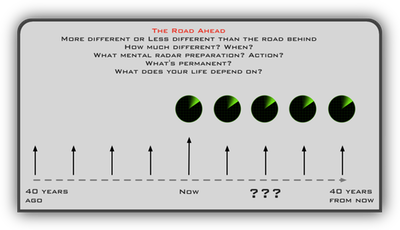
The economic and social health of our world
depends on
our capacity to navigate unimagined futureS
(and not be prisoners of the past)
The assumption that tomorrow is going to be
an extrapolation of yesterday sabotages the future — an
organization’s, a community’s and a nation’s future.
The assumption ↑ sabotages future generations — your children’s,
your grandchildren’s and your great grandchildren’s — in
spite of what the politicians say …
The vast majority of organization and political power structures
are engaged in this ↑ futile mind-set …
while rationalizing the evidence
The future is unpredictable and that means
it ain’t going to be like today
(which was designed & produced yesterday)
The capacity to navigate is governed by what’s between our ears ↑ ↓

When we are involved in doing something ↑
it is extremely difficult to navigate
and very easy to become a prisoner of the past.
We need to maintain a pre-thought ↓
systematic approach to work and work approach ↓
Click on either side of the image below to see a larger view
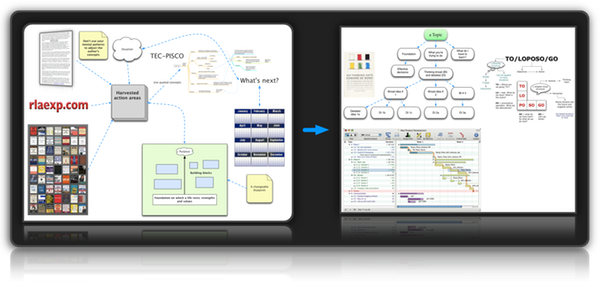
based on reality →
the non-linearity of time and events
and the unpredictability of the future
with its unimagined natureS. ↓ ↑
(It’s just a matter of time before we can’t get to the future
from where we are presently)
Foundations and opportunities ::: larger view ↓
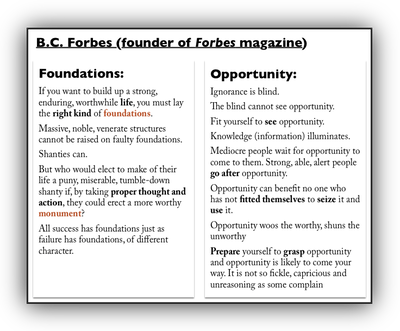
Intelligence and behavior ↑ ↓ ← Niccolò Machiavelli ↑ ↓
Political ecologists believe that the traditional disciplines define fairly narrow and limited tools rather than meaningful and self-contained areas of knowledge, action, and events … continue
❡ ❡ ❡
Foundational ↑ Books → The Lessons of History — unfolding realities (The New Pluralism → in Landmarks of Tomorrow ::: in Frontiers of Management ::: How Can Government Function? ::: the need for a political and social theory ::: toward a theory of organizations then un-centralizing plus victims of success) ::: The Essential Drucker — your horizons? ::: Textbook of Wisdom — conceptual vision and imagination tools ::: The Daily Drucker — conceptual breadth ::: Management Cases (Revised Edition) see chapter titles for examples of “named” situations …

What do these ideas, concepts, horizons mean for me? continue
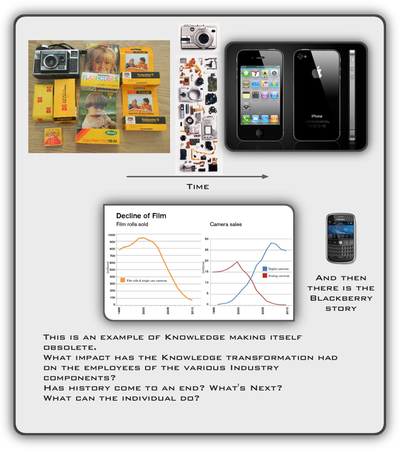
Society of Organizations
“Corporations once built to last like pyramids
are now more like tents.
Tomorrow they’re gone or in turmoil.”

“The failure to understand the nature, function, and
purpose of business enterprise” Chapter 9, Management Revised Edition
“The customer never buys ↑ what you think you sell.
And you don’t know it.
That’s why it’s so difficult to differentiate yourself.” Druckerism
“People in any organization are always attached to the obsolete —
the things that should have worked but did not,
the things that once were productive and no longer are.” Druckerism
Why Peter Drucker Distrusted Facts (HBR blog) and here
Best people working on the wrong things continue
Conditions for survival
Going outside
Making the future — a chance for survival ↑
“For what should America’s new owners, the pension funds,
hold corporate management accountable?” and
“Rather, they maximize the wealth-producing capacity of the enterprise”
Search for the quotes above here
Successful careerS are not planned ↑ here and ↓
What do these issues, these challenges mean for me & … — an alternative
Exploration paths → The memo they don’t want you to see ::: Peter Drucker — top of the food chain ::: Work life foundations (links to Managing Oneself) ::: A century of social transformation ::: Post-capitalist executive interview ::: Allocating your life ::: What executives should remember ::: What makes an effective executive? ::: Innovation ::: Patriotism is not enough → citizenship is needed ::: Drucker’s “Time” and “Toward tomorrowS” books ::: Concepts (a WIP) ::: Site map a.k.a. brainscape, thoughtscape, timescape
Just reading ↑ is not enough, harvesting and action thinking are needed … continue
Information ↑ is not enough, thinking ↓ is needed … first then next + critical thinking
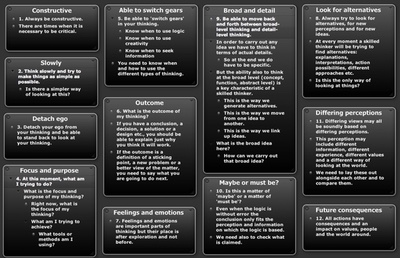
Larger view of thinking principles ↑ Text version ↑ :::
Always be constructive ↑ What additional thinking is needed?
Initially and absolutely needed: the willingness and capacity to
regularly look outside of current mental involvements continue
bread-crumb trail end

Peter Drucker: Conceptual Resources
The Über Mentor
A political / social ecologist
a different way of seeing and thinking about
the big picture
— lead to his top-of-the-food-chain reputation
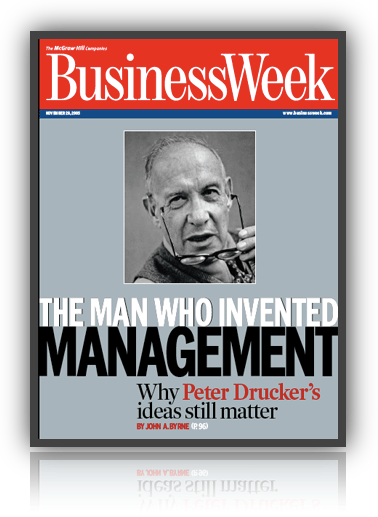
about Management (a shock to the system)
“I am not a ‘theoretician’; through my consulting practice I am in daily touch with the concrete opportunities and problems of a fairly large number of institutions, foremost among them businesses but also hospitals, government agencies and public-service institutions such as museums and universities.
And I am working with such institutions on several continents: North America, including Canada and Mexico; Latin America; Europe; Japan and South East Asia.” — PFD

List of his books
Large combined outline of Drucker’s books — useful for topic searching.

“High tech is living in the nineteenth century,
the pre-management world.
They believe that people pay for technology.
They have a romance with technology.
But people don't pay for technology:
they pay for what they get out of technology.” —
The Frontiers of Management
TLN Keywords: tlnkwdruckerbook
|
![]()
